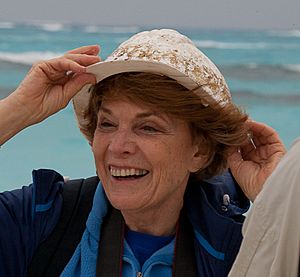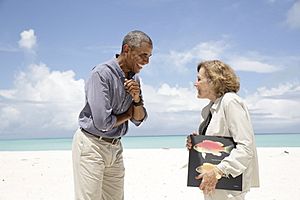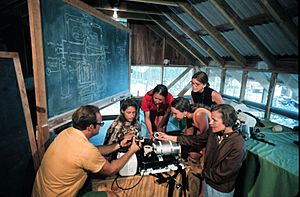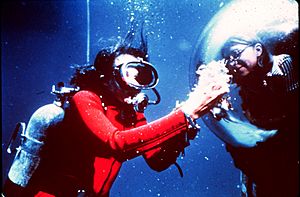Sylvia Earle facts for kids
Quick facts for kids
Sylvia Earle
|
|
|---|---|

Earle in 2012
|
|
| Born |
Sylvia Alice Reade
August 30, 1935 Gibbstown, New Jersey, U.S.
|
| Alma mater | |
| Spouse(s) |
John Taylor
(m. 1957; div. 1963)Giles Mead
(m. 1966; div. 1975)Graham Hawkes
(m. 1986; div. 1992) |
| Children | 3 |
| Awards |
|
| Scientific career | |
| Fields | Oceanography Marine Conservation |
| Institutions | NOAA, National Geographic |
| Thesis | Phaeophyta of Eastern Gulf of Mexico |
| Author abbrev. (zoology) | Earle |
Sylvia Alice Earle (born August 30, 1935) is an American marine biologist, oceanographer, and explorer. She has spent her life studying and protecting the ocean. Since 1998, she has been a National Geographic Explorer at Large.
Sylvia Earle was the first female chief scientist for the U.S. National Oceanic and Atmospheric Administration (NOAA). Time Magazine called her their first "Hero for the Planet" in 1998. She is also part of a group called Ocean Elders, which works to protect the ocean and its amazing wildlife.
Earle was featured in the 2021 Netflix documentary Seaspiracy. In the film, she shared her views on ocean health. She eats a vegetarian diet. She explains that large fish can have chemicals in them. Also, 90% of big fish populations have disappeared. She believes that eating less seafood helps the oceans stay healthy. She has said that the commercial fishing industry, with its "factory ships," is like using bulldozers to catch songbirds.
At a conference in California, Earle warned about fish disappearing from the oceans. She explained that while people near the coast have eaten seafood for centuries, today's large-scale fishing doesn't make sense. She encourages people to eat more plant-based foods to help the ocean.
Contents
Early Life and Learning
Sylvia Earle was born in 1935 in Gibbstown, New Jersey. Her parents, Alice and Lewis Earle, loved the outdoors. They supported Sylvia's early interest in nature. When she was a child, her family moved to Dunedin, Florida, on the state's west coast.
Earle went to St. Petersburg Jr. College and earned an associate degree in 1952. She then got a Bachelor of Science degree from Florida State University in 1955. She continued her studies at Duke University, earning a Master of Science degree in 1956 and a doctorate in Phycology (the study of algae) in 1966.
Sylvia Earle's work was greatly inspired by Rachel Carson. Carson was a famous writer whose book The Sea Around Us came out in 1951. Earle wrote the introduction to a later edition of Carson's book. She admired how Carson could imagine herself as part of the ocean. Carson's writings showed a deep understanding of fish, birds, and other animals.
Exploring the Ocean
After getting her Ph.D. in 1966, Earle became a research fellow at Harvard University. She also worked at the Cape Haze Marine Laboratory in Florida. From 1969 to 1981, she was a research associate at the University of California, Berkeley.
In 1969, Earle wanted to join the Tektite Project. This project involved living in an underwater lab 50 feet deep off the Virgin Islands. Scientists could live there for weeks to study the sea. Even though she had spent over 1,000 hours underwater, she was not chosen at first. The next year, however, she was picked to lead the first all-female team of aquanauts in Tektite II.
From 1979 to 1986, Earle was the Curator of Phycology at the California Academy of Sciences. In 1979, she made a record-breaking dive. She used a special JIM suit to dive 381 meters (about 1,250 feet) deep near Oahu. This is still the women's depth record for an untethered dive.
From 1980 to 1984, she advised the National Advisory Committee on Oceans and Atmosphere.
In 1982, Sylvia Earle and her future husband, Graham Hawkes, started a company called Deep Ocean Engineering. They designed and built underwater systems. In 1985, their team created the Deep Rover research submarine. This submarine could go down to 1,000 meters (about 3,280 feet).
In 1990, Earle became the Chief Scientist at the National Oceanic and Atmospheric Administration (NOAA). She was the first woman to hold this important job. She stayed at NOAA until 1992. During this time, she used her knowledge of oil spills to help study the damage from the Persian Gulf War in 1991.
In 1992, Earle started another company, Deep Ocean Exploration and Research (DOER Marine). This company builds and operates equipment for deep-ocean environments. Her daughter, Elizabeth, now runs the company.
"Her Deepness" and Hope Spots
In 1998, Sylvia Earle became a National Geographic Explorer in Residence. She is now known as an 'Explorer at Large'. People sometimes call her "Her Deepness" or "The Sturgeon General" because of her deep knowledge of the ocean.
From 1998 to 2002, she led the Sustainable Seas Expeditions. This program studied the United States National Marine Sanctuary areas. She also helped with the Ocean in Google Earth.
In 2009, Earle started Mission Blue. This organization works to protect the ocean. She also received the TED Prize, which helped her continue her ocean advocacy.
Because of her experience with past oil spills, Earle was asked to help during the Deepwater Horizon Disaster in the Gulf of Mexico in 2010. She also gave a speech at a United Nations conference that year.

In July 2012, Earle led an expedition to NOAA's Aquarius underwater lab in Florida. This trip celebrated 50 years of living under the sea. They studied coral reefs and ocean health.
In 2018, the Seattle Aquarium gave Sylvia Earle its first Lifetime Achievement Award. They also renamed their medal in her honor.
Mission Blue aims to create marine protected areas around the world. These areas are called "Hope Spots." The goal is to protect 30% of the ocean by 2030. Over 200 organizations support this mission. As of 2020, Mission Blue had created 122 Hope Spots. Past expeditions have included Cuba, Belize, and the Galápagos Islands.
In August 2014, a Netflix documentary called 'Mission Blue' was released. It tells the story of Earle's life and her campaign to create a global network of protected ocean areas.
In 2019, an article described Hope Spots as "areas critical to the health of the ocean." These can be places with many different species, unique habitats, or important cultural value. The article also mentioned that seamounts (underwater mountains) are targets for mining companies looking for metals.
In January 2020, Aurora Expeditions announced that their second ship would be named The Sylvia Earle.
Earle supports the "30X30 movement," which aims to protect 30% of ocean waters by 2030. This would be a big increase from the 6% protected in 2021. She also believes that harming the environment on a large scale, called "ecocide," should be a crime. She has said, "Our existence is on the line."
In June 2024, Sylvia Earle met with officials in the Philippines to talk about protecting marine life. She dived in the Verde Island Passage, which Mission Blue named a "Hope Spot" in July 2023. Also in June 2024, Earle joined the Advisory Board of Climate Cardinals, a large youth-led climate organization.
Awards and Recognitions
Sylvia Earle has received many awards for her work:
- 1970: U.S. Department of Interior Conservation Service Award
- 1976: NOGI Award for Science
- 1980: Explorers Club Lowell Thomas Award
- 1981: Knight of the Order of the Golden Ark
- 1986: Set the women's record for a world solo dive depth
- 1990: Society of Woman Geographers gold medal
- 1991: American Academy of Achievement Golden Plate Award
- 1996: Lindbergh Foundation award, the Explorers Club Medal
- 1998: UN Global 500 Laureate and National Wildlife Federation Conservationist of the Year
- 2000: National Women's Hall of Fame, Library of Congress Living Legend, Women Divers Hall of Fame
- 2001: Robin W. Winks Award for Public Understanding of National Parks
- 2009: TED Prize
- 2009: Rachel Carson Award from the National Audubon Society
- 2010: Roy Chapman Andrews Distinguished Explorer Award
- 2010: Carl Sagan Award for Public Understanding of Science
- 2013: Hubbard Medal, the National Geographic Society's highest honor
- 2014: UN Lifetime Achievement Award (Champions of the Earth)
- 2017: Rachel Carson Prize
- 2018: Seattle Aquarium Lifetime Achievement Award
- 2018: Princess of Asturias Award of Concord
- 2023: Stibitz-Wilson Award from the American Computer & Robotics Museum
See also
 In Spanish: Sylvia Earle para niños
In Spanish: Sylvia Earle para niños



